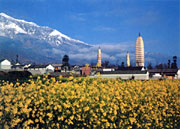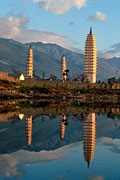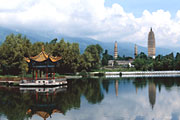|
THREE PAGODAS ON THE RUINS OF CHONGSHENGSI
MONASTERY
 The Three Pagodas are located at the foot of Yingle
Peak of Cangshan Mountain at the northwest suburb of Dali Ancient
City. In the time of Nanzhao and Dali Kingdoms, Chongshengsi was
the largest monastery in this area and the Three Pagodas were only
a part of it. Now, the monastery has long disappeared and only the
Three Pagodas remain. The Three Pagodas are located at the foot of Yingle
Peak of Cangshan Mountain at the northwest suburb of Dali Ancient
City. In the time of Nanzhao and Dali Kingdoms, Chongshengsi was
the largest monastery in this area and the Three Pagodas were only
a part of it. Now, the monastery has long disappeared and only the
Three Pagodas remain.
Between Cangshan Mountain and Erhai Lake, the Three
Pagodas stand like the legs of a huge tripod. Qianxun Pagoda, the
main one, is square-shaped with closed eaves similar to Xiaoyan
Pagoda in Xi'an. It has 16 tiers with a total height of 69.13
metres, and is in a typical architectural style of the Tang
Dynasty. At the basement of the pagoda are engraved four Chinese
Characters "YONG ZHEN SHAN CHUAN" (meaning everlasting sovereignty
and peace) in the handwriting of Mu Shijie, grandson of Mu Ying,
the Senior Duke of Qian of the Ming Dynasty. It was first built in
the era of Fengyou Emperor of Nanzhao Kingdoms about the same time
of the Tang Dynasty. On the south and north sides of the main
pagoda stand two smaller ones of octagonal shape with dosed eaves.
Each one has 10 tiers with a height of 43 metres. On the top of
each pagoda, there are three copper-made calabashes, each
connected with an umbrella shaped bronze bell. They were
constructed during the period of the Five Dynasty (907-906),
slightly later than the main one. The cover of Qianxun Pagoda is
white-washed. On each story, there are four shines. There
 are
Buddhist sculpture on the east and west shrines. The other two
shrines are the windows for the pagoda. There are wood beams
inside the pagoda. Along stairs inside, one can reach the top.
There are four corners on the summit. Each corner hangs a golden
wing bird cast by copper. Legend has it that these birds have
spell on the demons in Erhai Lake. On the summit of the pagoda,
there are also metal pagoda top, pagoda cover, pagoda peak and a
golden cock. On the base of the pagoda, there is a epigraph: The
Ruler of Mountains and Rivers. There are pillars at very corner
and platform on each story. On the fourth and sixth floor, there
are embossed, and golden were there, so splendid. are
Buddhist sculpture on the east and west shrines. The other two
shrines are the windows for the pagoda. There are wood beams
inside the pagoda. Along stairs inside, one can reach the top.
There are four corners on the summit. Each corner hangs a golden
wing bird cast by copper. Legend has it that these birds have
spell on the demons in Erhai Lake. On the summit of the pagoda,
there are also metal pagoda top, pagoda cover, pagoda peak and a
golden cock. On the base of the pagoda, there is a epigraph: The
Ruler of Mountains and Rivers. There are pillars at very corner
and platform on each story. On the fourth and sixth floor, there
are embossed, and golden were there, so splendid.
During the renovation in 1979, more than 600 pieces
of cultural relics were discovered, including hand-written
Buddhist scriptures, books, engraved bronze plates, bronze
mirrors, statues of Buddha made of gold, silver, bronze, iron,
porcelain, jade, and quartz, and medicinal herbs. Up to now, they
constitute the largest store of relics of Nanshao and Dali
Kingdoms ever found, providing sure proofs of the influence of the
Han culture upon minority nationalities in the border areas.
The bell tower behind the Three Pagodas was set up
in 1997. A jianji Bell hangs from the upper part of the building.
It sounds louder when one taps on it with mighty power. One can
hear the voice from the other world. This is one of 16 famous
scene in Dali - The Bell Shapes the Capital of Buddhist. famous
scene in Dali - The Bell Shapes the Capital of Buddhist.
Weathering through the storms and earthquakes in
the past to 10 centuries and more, the Three Pagodas still
elegantly stand there. They are the symbols of outstanding
architectural technology, the wisdom of the ancient labouring
people and the brilliant culture of Dali.
|